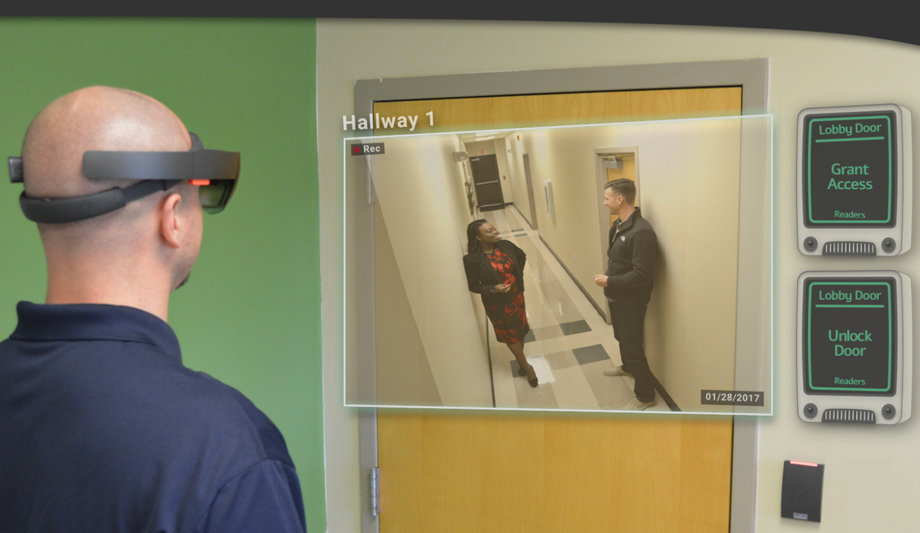“Mixed reality” may seem like a strange term to apply to the physical security industry, but it describes a new approach to enable the features of access control and video surveillance systems to be used by operators in the field. Mixed or augmented reality technology combines a real-time view of the world through Microsoft’s HoloLens headset, with placement of virtual devices and controls as holograms in a three-dimensional space.
Virtual devices and controls
In effect, a security guard wearing a HoloLens headset can approach a door in his facility and see the real-time status of that door, provided by an access control system, projected as a hologram alongside his live view of the door. It’s the first implementation of a technology with many possibilities. Related to video surveillance, real-time facial recognition could provide the identity of a person walking past a security officer in a hallway, for example.
Basically, the approach extends the interfaces and capabilities available in a control room to a security officer on patrol. The officer can place and interact with a variety of virtual devices and controls as holograms in the 3-D space he or she views through the headset.
Augmented Reality for Integrated Electronic Security
The security industry technology has been developed by CodeLynx, a software engineering and systems integration company headquartered in North Charleston, S.C. As a systems integrator, CodeLynx specialises in audio-visual and physical security design and installation for A/V, access control and video surveillance systems. A complementary business is software engineering; Darren Cumbie, Director of the Software Engineering Division, and his team provide custom integrations of various technologies.
The approach extends the interfaces and capabilities available in a control room to |
CodeLynx has developed software to adapt Microsoft’s HoloLens product for use in the physical security field. They are bringing it to market as ARIES (Augmented Reality for Integrated Electronic Security). The software operates using Microsoft’s HoloLens, introduced in 2016, a powerful, self-contained holographic computer worn as a headset. Specialised components enable holographic computing in lockstep with advanced sensors, including five cameras. Users can move freely throughout an environment and interact with holograms that augment the reality they view through the HoloLens. Cumbie says HoloLens provides the best mixed reality headset currently available: “Nothing else has the power, usability and scalability across an organisation.”
AMAG Symmetry access control integration
In ARIES, CodeLynx has created a certified integration with AMAG’s Symmetry access control system to enable operators to view information from Symmetry as holograms in their field of view through the HoloLens. The integration extends the functioning of Symmetry to operators in the field, thus expanding the control room environment. Holograms can be created and positioned for each user, and they function just like physical devices, tied into Symmetry. Approaching a door, an operator can request a list of the last five people who came through the door, for example; he or she can see a photo ID related to each person who swipes through a turnstile. CodeLynx is looking to expand the market for ARIES using integrations with other OEMs in addition to AMAG.
“Instead of being chained to their desk looking at monitors or a display wall, operators can work in the field using the full functionality of their systems as they walk throughout the property,” says Drew Weston, CodeLynx Director of Sales and Marketing. “Meanwhile, I am not sitting at a desk, I am out in public.”
Holograms can be created and positioned for each user, and they function just like physical devices, tied into Symmetry |
At some point, the headsets will likely get lighter and more ergonomically appealing. Right now, all the computing power is inside the headset (which, even so, only weighs only 1.3 lbs). In the future, more of that computing will likely be “offloaded” to a nearby desktop or laptop computer, or even to the cloud, and wirelessly “tethered” to the headset. In addition to making the headsets lighter and more ergonomically appealing, tethering would bring down costs from the current $5,000 per headset (possibly into the “three digit” range). CodeLynx is poised to leverage any Microsoft enhancements to the HoloLens environment. Currently the software is priced at $1,500 per user.
Benefits for systems integrators
For systems integrators, ARIES could be used to simplify installations, given its ability to view camera frames through the headset hands-free rather than needing to view a separate laptop when focusing or positioning a camera. For maintenance or troubleshooting, an operations center could access the field user’s view and direct him or her to correct a problem. In this way it would be a training tool to help integrators, which is a separate value proposition from how the devices may be deployed by end users.
The ARIES approach could also eventually change how we think of a control room. Instead of video screens and walls, operators might sit in comfortable chairs in rooms with white walls, viewing all the control room “screens” through their headsets as holograms. Less power consumption would be among the benefits. ARIES plans to offer a “virtual operations centre” in 2018, enabling command centre operation from anywhere, user-customisable layout views and the ability to push content to specific HoloLens users.
This video demonstrates how interaction with holograms can drive security functions: https://www.youtube.com/watch?v=B82oAlxt5_s









